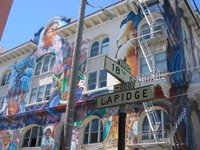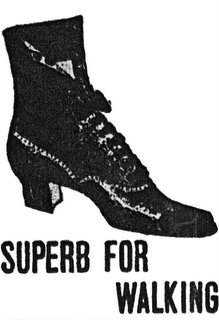
In the Mission district, Lapidge is best known for sneaking up next to the spectacular mural that wraps around the Women’s Building on 18th Street. Stroll the quiet block that is Lapidge and lull into calm until you hit the shock waves of brilliant orange, yellow, blue swirls around Surgeon General Joselyn Elders, Nobel Peace Laureate Rigoberto Menchu, the Chinese goddess of mercy Quan Yin, the African slaves’ goddess of the sea Yamenja. Painters created the mural to celebrate paying off the mortgage on the building. They chose the medium of a mural to celebrate the neighborhood’s Mexican heritage. They chose the the theme of powerful women through time and across cultures to celebrate feminine strength and vibrancy.
 (Map)
(Map)Of course Lapidge didn't pop into existence in some sort of recent birthing ceremony. It shows up in city maps from 1898. And, folks have been living along Lapidge for a hundred years or more before the Women’s Building existed.
o On December 15, 1902, starting at 2:30, Isabell Campbell, the widow of Irish native Francis Campell (from County Monaghan), gathered together friends and relatives at their home, 35 ½ Lapidge, to celebrate the life of Francis, who had died the day before. Three years and four months later, the Campbell residence was destroyed in the fire that swept the city after the 1906 earthquake. (Thanks to Susan Cherry-Boyer for the transcription of the death notice.)
o In 1922, number 63 Lapidge was home to Mrs. M. Fritz, or so it would appear from the 1922 edition of Who’s Who among the Women of California.
o And, in 2004, the 1908 Vic at 79 Lapidge sold in 2004 for $1.1m. A year later, its next door neighbor (77) was on the market for a mere $790,000.
Lapidge is not a common name. It isn't the name of a U.S. president or a Mexican settler. Where did it come from? Perhaps this short street was named for W.F. (or W.E.) Lapidge, the sea captain who sailed for the Pacific Mail Steamship Co. on the route between San Francisco and Panama in the 1860s (before the transcontinental railroad). (For more on Capt. Lapidge, see: Maritime Heritage, Transcriptions from the Sacramento Bee, and Docking of the Colorado.)

No comments:
Post a Comment